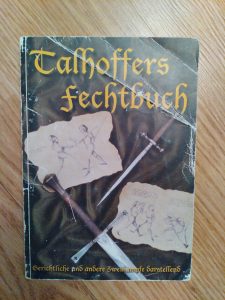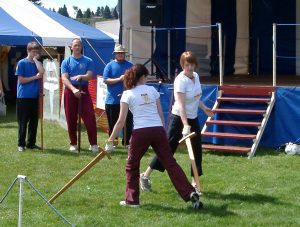Way back when our school was founded, in 1994, we had a very basic curriculum. The members of our school had already been involved in the Society for Creative Anachronism (SCA) for as much as eight years. We all fought in some manner or other, whether “light” or “heavy”, and wanted to understand the reality of mediaeval combat, as it was fought by those who lived and died by this martial art.
We came across a magazine article that talked about the martial arts of Germany in the Middle Ages. It had a few guards drawn for longsword, done with stick figures. The article was written before we even knew there were treatises available, and before our school was officially founded. This was probably in 1992, when we started doing all of this. At first, we practiced with the SCA, just stepping off to the side during their practices to do our own thing. It took a couple more years before we broke away from them. This was because we finally had something that was a bit of a curriculum of our own. We were going in a very different direction than those who were interested in re-enactment fighting. We wanted a martial arts club.
For at least a couple of years we worked off the article from 1992 and trying to figure things out from stories, sagas, and artwork. Johanus graduated with his bachelor’s degree in Education in 1992. For most of the next year Johanus didn’t participate, as he lived in Wetaskiwin from September 1992 to April 1993. In August he rejoined and started helping again with classes. Johanus’ knowledge as a teacher helped because he knew how to do proper curriculum design and teaching pedagogy. So, in 1994 we wrote up our first, simple curriculum. It consisted of basic body movements, balance, how to hold a sword, proper striking mechanics (which hasn’t changed much since then – we at least had the basics all correct), and a few tactics. There was no division between weapons, like our current curriculum. This was also the year we formalized our group, and The Academy of European Swordsmanship was officially created.
The first treatise we had a hold of was Talhoffer’s 1467 book. It was only available in German, from a transcription done in 1887, published in 1998. When we got the Talhoffer book, we started expanding that basic curriculum to include specific techniques. Naturally these were almost all from that treatise. The information from Talhoffer expanded our knowledge so much we can’t even quantify it! Thankfully, Johanus had a basic understanding of German. This was much better than when we had no formal curriculum and would just practice movement, sword techniques, and strategy as we saw fit. And even far better than the basic curriculum we had before we found this treatise.
Over the years our curriculum has developed and expanded greatly. There is so much knowledge we have that we have divided everything after a certain point into the different weapons used, including unarmed combat (including wrestling), knife/dagger, longsword, polearms, Messer, rapier, arming sword, sidesword, backsword, saber, and axe. At the beginning levels of our curriculum there is common knowledge taught, and it only starts to differentiate when appropriate, by weapon type. All weapons have some common core in the curriculum. Basic movements, concepts, and tactics all have some overlap. Today, there is so much to learn that one couldn’t possibly internalize our entire curriculum without decades of study. So, people pick and choose. Most students want to know longsword. A few prefer some kind of one-handed sword, such as sidesword or Messer. And cross training is encouraged!

